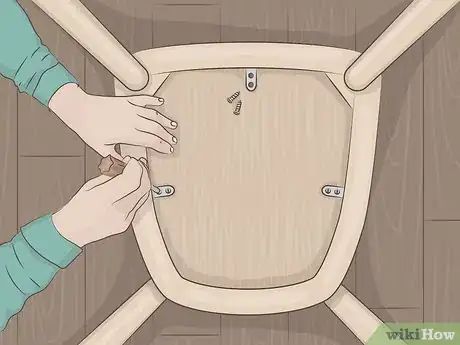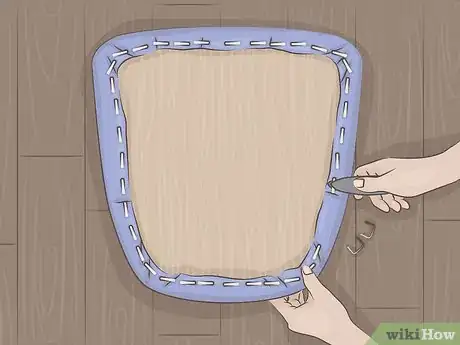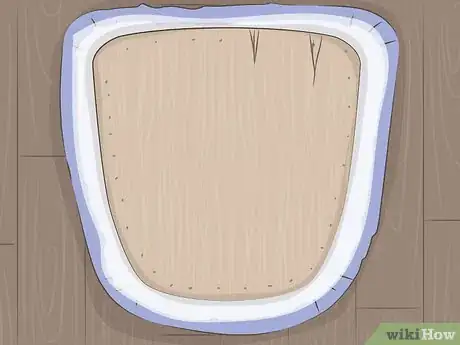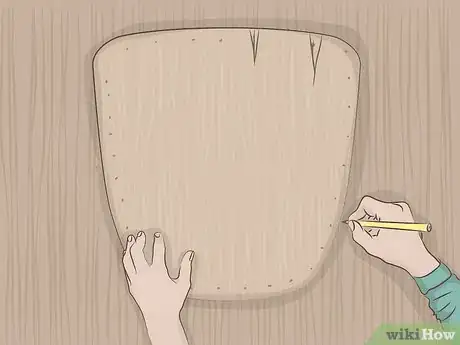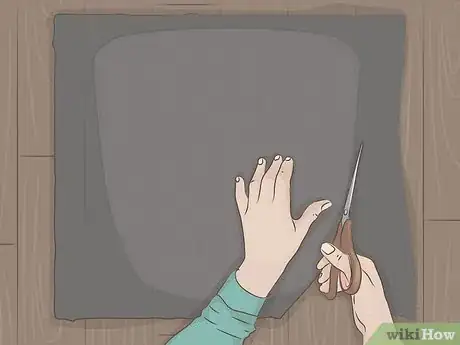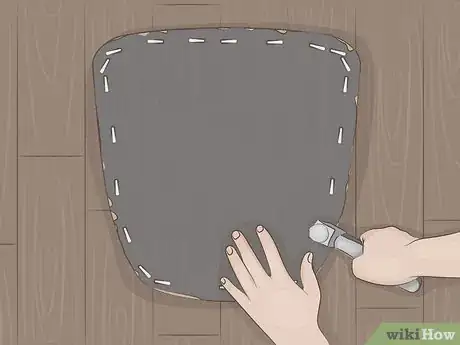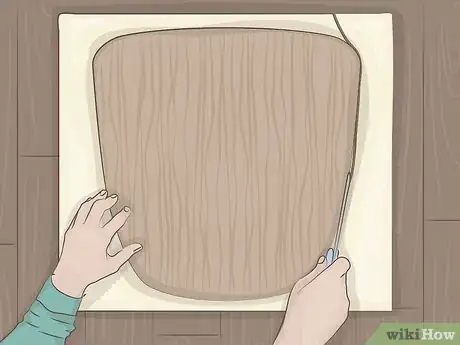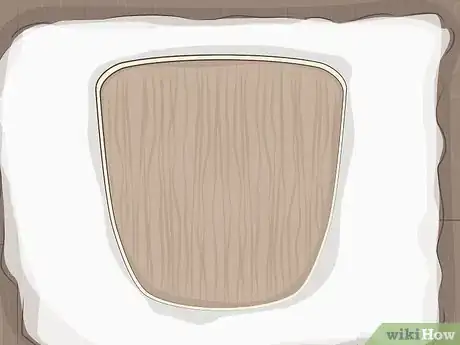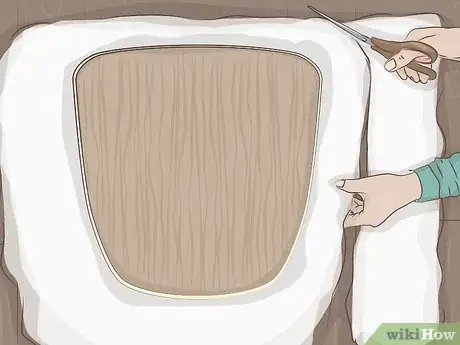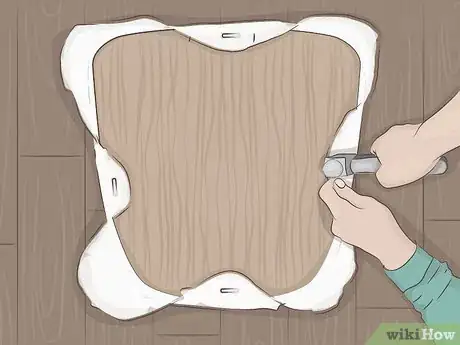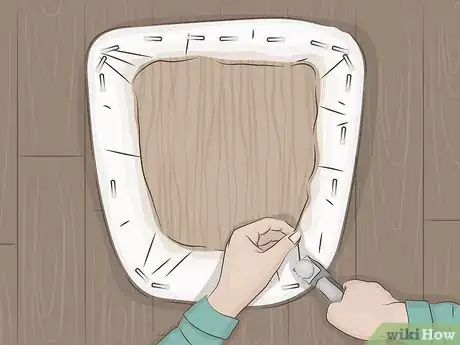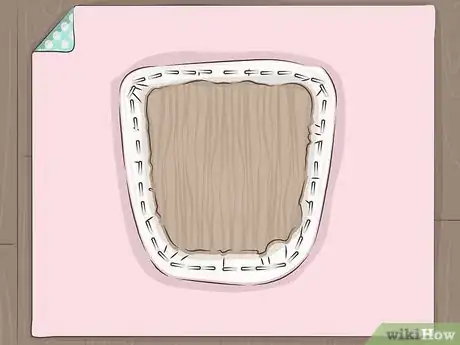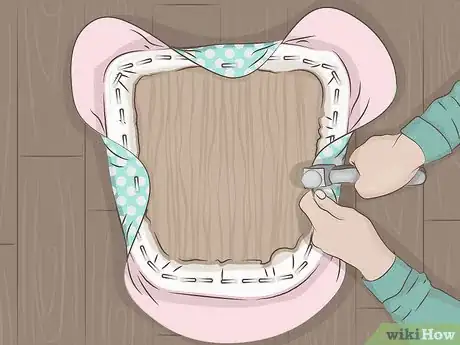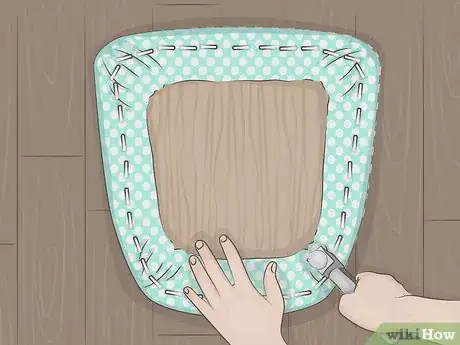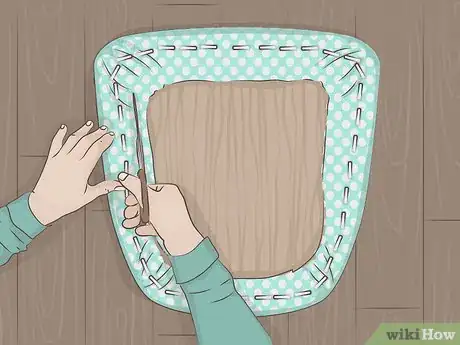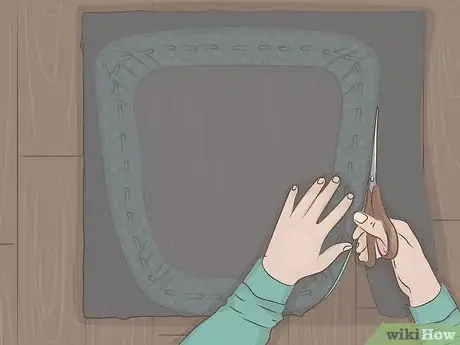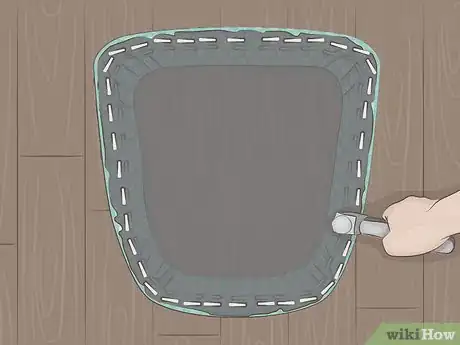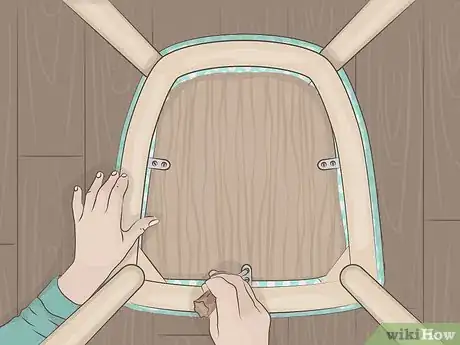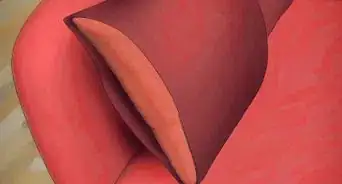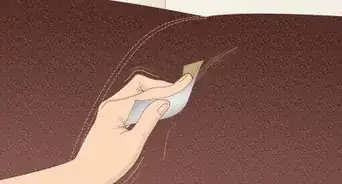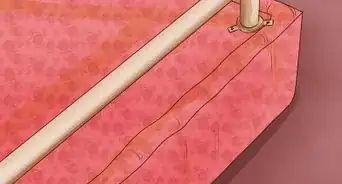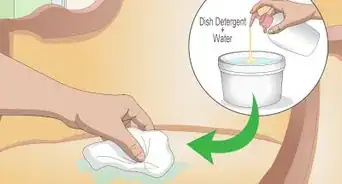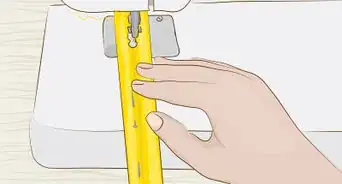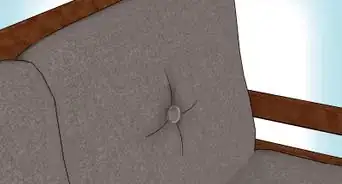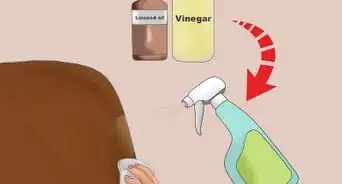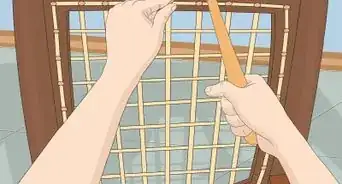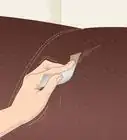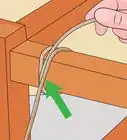This article was co-authored by Katherine Tlapa. Katherine Tlapa is an interior designer, currently working as a Design Specialist for Modsy, a design service based in San Francisco. She also runs her own DIY Home Design blog, My Eclectic Grace. She received her BFA in Interior Architecture from Ohio University in 2016.
There are 21 references cited in this article, which can be found at the bottom of the page.
wikiHow marks an article as reader-approved once it receives enough positive feedback. This article received 25 testimonials and 90% of readers who voted found it helpful, earning it our reader-approved status.
This article has been viewed 1,388,361 times.
A high-impact way to improve or change the look of any chair with a removable seat is to reupholster the seat with new fabric. If the seat's padding isn't very comfortable, add new foam and batting for a more comfortable seat. Whether your seat is damaged or you just love to recycle old furniture, you'll appreciate this quick refurbishing technique!
Steps
Removing the Old Chair Covers
-
1Unscrew the dining chair seat from the base. Use a screwdriver to loosen the screws attaching the dining chair seat to the chair base. Turn the screwdriver to the left to loosen the screws. Make sure to save the screws for reattaching the seat to the chair base after you are done.[1]
-
2Remove the tacks or staples to loosen the fabric. Use the back of a hammer or a re-upholstery multi-tool to remove the tacks that are holding the fabric onto the seat. Work the end of the tool under the tack or staple and then pull it up.[2]
- Discard the tacks or staples since you will be using a staple gun to attach the new materials.
Advertisement -
3Pull off the fabric and padding. After you have removed all of the tacks or staples, lift the fabric off of the seat. If you plan to replace the seat’s padding, then lift this off of the seat as well.[3]
- For older chairs, the padding may be made up of a mixture of hay and cloth, so replace this with foam.
-
4Check the seat base and replace it if needed. Make sure that the seat base is sturdy. If it appears damaged or weak, then you may want to replace it. Purchase a replacement seat base or cut a piece of plywood to the dimensions of your seat base and attach the new foam and upholstery to it.[4]
- An easy way to get the dimensions you need is to place the old seat on the plywood and trace around the edges of the old seat with a marker or pen. Then, use a hand saw to cut along the lines you traced.
Replacing the Dust Cover and Padding
-
1Cut a piece of the dust cover fabric to the dimensions of the seat. Place the dust cover fabric over the seat base and cut around the edges of the set to get the exact dimensions. This piece will be hidden under the foam and fabric, so don’t worry if the edges are a little jagged.[5]
- A dust cover will help to prevent the cushion from sagging down into the seat base.
-
2Staple the dust cover to the top of the seat. Place the dust cover onto the seat base and staple around the edges to secure it to the seat base. Make sure that the fabric is taut. You may want to place 1 staple at the center of each side to start and then work outwards on each side, pulling the fabric as you go.[6]
-
3Cut 2 in (5.1 cm) thick foam padding to the dimensions of the seat.[7] Place the seat frame directly onto the foam. Trace around it using a pen or marker. Then, use a serrated knife or an electric knife to cut out the foam using the lines you traced onto it as guides.[8]
- A bread knife or turkey carving electric knife work well for cutting foam padding.[9]
-
4Place the foam padding and seat onto a piece of batting. After you have the foam cut out, place it onto the seat frame so that the edges of the foam and seat are lined up. Place the foam directly on the batting and the seat frame on top of the foam. Make sure that the foam and seat are centered on the batting.[10]
- Don’t worry about the dimensions of the batting. Use a large piece and cut what you need after you have the seat and foam in position.
-
5Cut the batting 2 in (5.1 cm) past the seat’s edges. The edges of the batting need to go up and over the edges of the back of the seat by 2 inches (5.1 cm) on all sides. Check to ensure that you can wrap the batting around by 2 inches (5.1 cm) on all sides and then cut the batting to these dimension.[11]
- Mark the batting to indicate where to cut it or cut it while it is wrapped over the edge of the seat.
-
6Staple the batting to the center of the seat and then work outwards. Staple the center of each edge of the batting first, and then continue stapling along the edges on each side. Pull the padding taut along each edge as you staple it. Work from the center staple out towards a corner of the seat and repeat this on both sides of the staple. Then, do the same thing for each of the other sides.[12]
-
7Fold the batting at the corner and staple to secure it. Gather the excess fabric at 1 corner of the seat, and then fold it over at the corner. Staple in the center of the fold to secure the fabric at the corner of the seat. If there is still some extra fabric, fold it again and place another staple over the fold to secure it.
- Repeat this for each corner of the chair.
-
8Cut the excess batting 1 inch (2.5 cm) from the staples. Once the batting is secured to the seat, cut the excess to reduce the bulk and prevent any hanging fabric. Cut about 1 inch (2.5 cm) from the staples all around the inside of the seat.[13]
- Don’t cut the batting too close to the staples or it may come loose.
Cutting and Attaching the New Upholstery
-
1Place the cushion on the fabric with the right (outer) side facing down. The batting and cushion should be right up against the fabric. Try to place the seat so that it is about 3 to 4 inches (7.6 to 10.2 cm) from the edges of the fabric, but don’t worry about getting it perfect. You can adjust it before you start cutting.[14]
- You may want to opt for a dark fabric to make stains less visible, or get a water-resistant fabric to protect your chair from spills.[15]
-
2Cut the fabric 3 to 4 inches (7.6 to 10.2 cm) from the edges of the cushion. You will need this much fabric all the way around the cushion to cover it. Measure or find where to cut by wrapping the edges of the fabric up and over the seat edges. Then, mark the fabric and cut it.[16]
-
3Staple the upholstery in the center of each of the 4 sides of the seat. Grasp the fabric on 1 side of the seat and pull it up and over the edge of the seat. Locate the center of the seat edge, and place a staple in the center of the edge to secure the fabric.[17]
- Repeat this for the other 3 sides of the seat.
- If the seat is round, then staple the upholstery to the underside of the seat in 4 equidistant locations, such as at 12 o’clock, 3 o’clock, 6 o’clock, and 9 o’clock.
-
4Pull and staple the fabric working out towards the corner. Choose 1 side of the seat to work on first. Grasp the fabric on the inside of the seat next to where you placed the first staple. Then, start stapling along the edge going out towards the corner of the seat, and then do the other side of the staple. However, do not staple the fabric at the corners of the seat yet.[18]
- Repeat this on all sides of the seat.
-
5Fold the fabric at the corners and staple in the center of the fold. Once the fabric is secured along the sides, choose a corner and fold the fabric over at the corner to gather it. Then, fold the fabric again, and staple the fabric a couple of times at the center of the fold to hold it in place.[19]
- Repeat this for all of the corners.
-
6Cut the excess fabric 1 in (2.5 cm) from the staples on each side. Once the fabric is secured at the corners, cut the fabric on the inside of the chair back 1 inch (2.5 cm) from the staples. This will prevent the excess fabric from hanging down.[20]
- Be careful not to cut the fabric too close to the staples or it may come loose.
-
7Cut the dust cover fabric to the same dimensions as the seat. To finish the seat, cut a piece of dust cover fabric to the same dimensions as the seat. You can place the fabric over the back of the seat and cut along the edges.[21]
- Be careful not to cut the upholstery fabric as you cut out the dust cover fabric.
-
8Fold the dust cover fabric under and staple the edges to the seat. Fold the dust cover fabric on 1 side of the chair and staple it into place. Staple the center of 1 side of the fabric first and then work out towards the edge.[22]
- Repeat this all the way around the edges of the chair to secure the dust cover.
-
9Reattach the seat to the chair base. Once you have finished securing the fabric, your reupholstered dining chair is complete! Use the screws that you saved to reattach the chair to its base.[23]
- If you have other chairs to reupholster, repeat the process for each of these chairs.
Expert Q&A
-
QuestionCan I reupholster a chair myself?
 Katherine TlapaKatherine Tlapa is an interior designer, currently working as a Design Specialist for Modsy, a design service based in San Francisco. She also runs her own DIY Home Design blog, My Eclectic Grace. She received her BFA in Interior Architecture from Ohio University in 2016.
Katherine TlapaKatherine Tlapa is an interior designer, currently working as a Design Specialist for Modsy, a design service based in San Francisco. She also runs her own DIY Home Design blog, My Eclectic Grace. She received her BFA in Interior Architecture from Ohio University in 2016.
Interior Designer Sure, you can do it yourself. First you'll first need to disassemble the cushion or the upholstered parts. Some dining chairs have seats that can be screwed right off and some are attached. If the padding is in good condition, you can cover the seat easily with new fabric. Either upholstery glue or staples are a simple way to attach the fabric where it is concealed. If you cannot dislodge the upholstered area of the chair, you'll need to neatly tuck the fabric around the edges and do something that will conceal the seams, such as roping or fabric beading.
Sure, you can do it yourself. First you'll first need to disassemble the cushion or the upholstered parts. Some dining chairs have seats that can be screwed right off and some are attached. If the padding is in good condition, you can cover the seat easily with new fabric. Either upholstery glue or staples are a simple way to attach the fabric where it is concealed. If you cannot dislodge the upholstered area of the chair, you'll need to neatly tuck the fabric around the edges and do something that will conceal the seams, such as roping or fabric beading. -
QuestionHow do I reupholster a dining chair that also needs new padding on the seat?
 Community AnswerBuy foam padding from the same store where you buy the fabric. It's expensive, so check around for deals or coupons.
Community AnswerBuy foam padding from the same store where you buy the fabric. It's expensive, so check around for deals or coupons. -
QuestionThe staples of my manual staple gun will not completely penetrate the composite material. What should I do?
 Community AnswerOnce the staples are started by the staple gun, you can often tap them flat with a small hammer. Alternatively, furniture tacks may be necessary; they are stronger and provide a higher quality appearance.
Community AnswerOnce the staples are started by the staple gun, you can often tap them flat with a small hammer. Alternatively, furniture tacks may be necessary; they are stronger and provide a higher quality appearance.
Things You’ll Need
- Hammer or reupholstery multi-tool
- Plywood (optional)
- Saw (optional)
- Pen or marker
- Screwdriver
- Dust cover fabric (about 0.5 yards (0.46 m) per chair)
- Scissors
- 2 in (5.1 cm) thick high-density foam padding (about 0.5 yards (0.46 m) per chair)
- Serrated knife or electric knife
- Batting (about 0.5 yards (0.46 m) per chair)
- Re-upholstery fabric (about 0.5 yards (0.46 m) per chair)
- Screws
- Staple gun
References
- ↑ https://youtu.be/MmQpQmhXbMo?t=55s
- ↑ https://youtu.be/MmQpQmhXbMo?t=1m11s
- ↑ https://youtu.be/MmQpQmhXbMo?t=1m44s
- ↑ https://www.bhg.com/decorating/makeovers/furniture/how-to-reupholster-dining-room-chairs/
- ↑ https://youtu.be/MmQpQmhXbMo?t=2m6s
- ↑ https://youtu.be/MmQpQmhXbMo?t=2m11s
- ↑ https://www.thinkingcloset.com/2016/02/28/how-to-reupholster-a-chair-seat-the-no-mess-method/
- ↑ https://youtu.be/MmQpQmhXbMo?t=2m21s
- ↑ https://www.thinkingcloset.com/2016/02/28/how-to-reupholster-a-chair-seat-the-no-mess-method/
- ↑ https://youtu.be/MmQpQmhXbMo?t=2m38s
- ↑ https://youtu.be/MmQpQmhXbMo?t=2m45s
- ↑ https://youtu.be/MmQpQmhXbMo?t=2m57s
- ↑ https://youtu.be/MmQpQmhXbMo?t=3m39s
- ↑ https://youtu.be/MmQpQmhXbMo?t=3m57s
- ↑ https://www.thinkingcloset.com/2016/02/28/how-to-reupholster-a-chair-seat-the-no-mess-method/
- ↑ https://youtu.be/MmQpQmhXbMo?t=4m3s
- ↑ https://youtu.be/MmQpQmhXbMo?t=4m11s
- ↑ https://youtu.be/MmQpQmhXbMo?t=4m20s
- ↑ https://youtu.be/MmQpQmhXbMo?t=4m47s
- ↑ https://youtu.be/MmQpQmhXbMo?t=5m7s
- ↑ https://youtu.be/MmQpQmhXbMo?t=5m18s
- ↑ https://youtu.be/MmQpQmhXbMo?t=5m28s
- ↑ https://youtu.be/MmQpQmhXbMo?t=5m43s
About This Article
If you want to reupholster a dining chair, unscrew the seat from the bottom of the chair and remove any tacks or staples holding the fabric in place. In most cases, you do not have to remove the existing padding, unless the padding is decaying or there is a strong odor. Cut the new fabric so it’s 3-4 inches longer than the size of the cushion on all sides. Next, staple the upholstery in the center of each of the 4 sides of the seat, then start on 1 side and pull and staple the fabric, working out toward the corner. Fold the fabric at the corners and staple at the fold, then continue all the way around the cushion. Keep reading to learn how to replace the padding and dust cover!!
